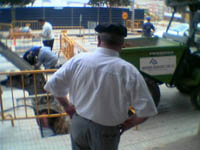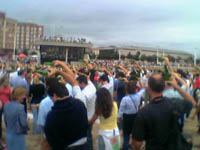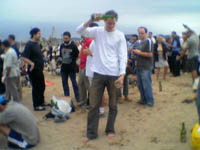Posted: August 30th, 2003 | No Comments »
Notas de mi curso de arte espanol en la Universidad de Oviedo.
Modernismo: Rupturo con la tradición histórica. Más que une escuela existen individualidades. Fantasía creadora. Formas vegetables. Línes curvas. Unión de arquitectura y decoración.
Gaudí (1852-1926): Inspiración en la naturaleza. La línea recta prácticamente desaparece. No se reconoce la arquitectura. Utilización de materiales de color. Toda adquiere movimiento. Tradición y mdernidad.
Velázquez (1599-1660): Primera etapa tenebrista. Retratos, temas mitológicos, religiosos, paisajes… Gran manejo de la luz. Conquista de la profundidad. Perspectiva aérea. Predominio del verde, azul y blanco en los fondos.
Goya (1746-1828): Su pintura sigue la evolución histórica. Amplia obra, variedad tanto iconográfica como técnicamente. La fantasía y la critica, motor de su orbra. Pincelada suelta, preocupación por la luz. Sus retratos son de gran penetración psicológica. Cartones para tapices: Pinturas al óleo sobre tela. Temas populares, fiestas, juegos. Gran colorido. Pinturas negras: Asuntos contemporáneos y mitológicos. Figuras grotescas. Crueldad, violencia. Mundo sin esperanza.
Grabados de Goya: Tauromaquia: Temática relacionada con el mundo del toro. Desastres: La guerra como actividad no heroica. Reflejo de tortura, muerte, hambre. Universalización de la guerra. Disparates: Lo absurdo lo domina todo. Figuras gigantescas. Incluso los asuntos de bromo adquieren un aire tenebroso y siniestro. Caprichos: Censura los errores y los vicios humanos. Universaliza los temas. Crítica pero can afán constructivo. Corrupción de costumbres. Superstición, anticlericalismo, ignorancia.
Arte Islámico: Arquitectura en armonía con el paisaje. Elementos constructivos (yeso, madera, ladrillo). Arcos de herraduura con dovelas alternando el color. Alfiz. Mayor decoración interior (temas de carácter vegetal). Pintura y escultura restringidas por motivos religiosos. Mezquita (construcción fundamental). Epoca califal (Mezquita de Córdoba – 786), Epoca almohade (Torre del Oro, Giralda de Sevilla – s. XIII), Epoca nazarí (Alambra de Granada – s. XIV).
Posted: August 30th, 2003 | No Comments »
Gelesen heute im Tagi: “Dagegen dümpelt Delémont, der andere NLA-Absteiger, weiter im hinteren Mittelfeld herum. Die Waadtländer unterlagen bei Malcantone Agno 2:4″.
Posted: August 28th, 2003 | 1 Comment »
Interesting document written by the city of Barcelona and reported in “The Knowledge City” that defines the attributes (check-list) for any city claiming to be a knowledge city:
- A city that has instruments to make knowledge accessible to citizens.
- A network of public libraries that is compatible with the European standards.
- Access to the new communication technologies for all citizens.
- All cultural facilities and services with a central educational strategy.
- A city that has a newspaper- and book-reading level that is similar to the average European level.
- A city that has a network of schools connected with artistic instruction throughout its territory.
- A city that is respectful of the diversity of cultural practices of its citizens.
- A city that places the streets at the service of culture.
- A city that simplifies, through the provision of spaces and resources, the cultural activity of the community collectivities and associations.
- A city with civic centres that are open to diversity and that foster face-to-face relations.
- A city that makes available to citizens from other territories all the tools required for them to express themselves.
Posted: August 27th, 2003 | No Comments »
According to a survey reported in the article Job Skills: Preparing Generation Z, communication/people skills should be taught to IT students. I would definitivly add “cultural competence” on top of the requirements. The message is clear for the nerds out there… 
Posted: August 25th, 2003 | No Comments »
“Imaginez un monde sans pronoms ni ponctuation. Un monde dans lequel toute pensée complexe doit être tronçonnée en éléments de sept mots, avec des trucs en couleurs au milieu. [...] Ce monde n’est pas une fiction. C’est la réalité contemporaine d’une présentation PowerPoint.”
En complément de précedents posts PowerPoint is Evil et Great things can happen when you move beyond the bullet point, Le Temps couvre les critiques autour l’utilisation de PowerPoint (dans le monde de l’éducation notamment) dans l’article “Bienvenue au show PowerPoint, là où la pensée complexe se réduit à un schéma simpliste“.
Posted: August 25th, 2003 | No Comments »
Image illustrant le post et ma discussion avec icon � propos des gens qui regarde les chantiers dans les villes. Cette activit� semble trans-culturelle, puisque pratiqu�e autant ardemment en Suisse, France qu’en Espagne o� les vieux aiment � observer les chantiers aux environs de 17h apr�s la siesta:

Dans le m�me ordre d’id�e, cela me fait penser aux nouvelles formes de tourisme urbain.
Posted: August 25th, 2003 | No Comments »
Article dans Le Monde sur le succès de Google, de son utilisation comme mot commun et de la possible dégénérescence de la marque.
Posted: August 23rd, 2003 | No Comments »
Be aware of your audience not simply as the relatively few people who own desktops or handhelds – take into account the truly ubiquitous set of technologies (cellphones, smartphones, smartcards, etc) that are a dominant part of everyone’s daily lives. Here is why expending my knowledge to pratctical J2ME matters.
Posted: August 23rd, 2003 | No Comments »
An introduction paper (Local Development Networks in Remote Areas and Knowledge Management) by Andra Aldea-Partanen on the role of social networks in policy making (innovation distribution, the role of informal and formal local networks, including them in a participatory process and building trust to leverage the discovery learning). Most importantly to me it defines concepts I am interested in including:
Social networks: “specific structures in which people as individuals and/or representatives of informal groups or formal organisations are inter-connected due to their common interests in one or more areas, sharing common norms and having certain expectations regarding their benefits”.
Learning regions: (american context:) “collector and repositories of knowledge and ideas and (that) provide and unerlying environment or infrastructure which faciliates the flow of knowledge, ideas and learning”. (european context:) “The territorial and institutional embeddednes of learning organisations and active learning”.
Trust: There is not only generalised trust (moralistic trust: based on belief that others share your fundamental moral values) but also the knowledge-based trust (presumes that trust depends on information and experience). The most important consequence of trust is that it forsters cooperation
Social capital: has three components: moral obligations and norms, social value (trust) and social networks (voluntary associations)
Posted: August 23rd, 2003 | No Comments »
Yo bati un record mundial escanciando sidra en la Fiesta de la Sidra Natural en Gijón!






